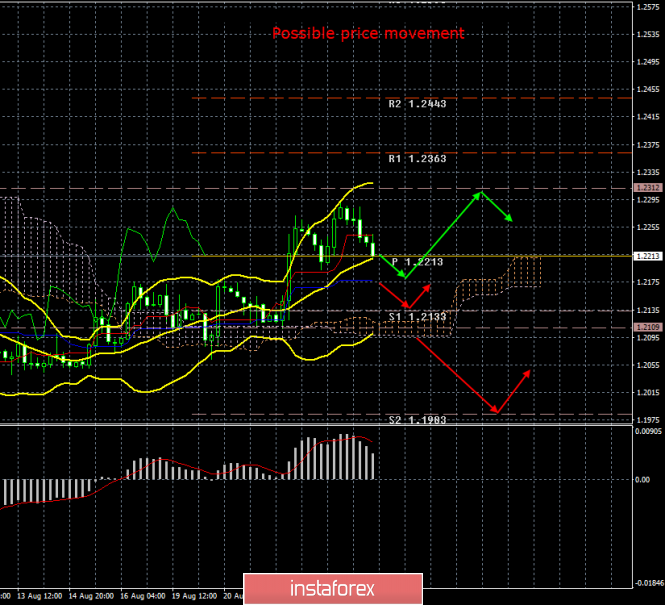4-hour timeframe

Amplitude of the last 5 days (high-low): 68p - 116p - 63p - 164p - 100p.
Average volatility over the past 5 days: 102p (high).
About 100 companies have already left the UK and about 300 are going to follow suit. One of the most popular countries for business emigration is the Netherlands. What does this mean for the pound? Nothing good for the whole of Great Britain. The emigration of companies negatively affects the number of jobs, as a result of unemployment and applications for unemployment benefits. The more applications, the greater the burden on the British budget, which may begin to experience a deficit. The fewer jobs, the less goods and services a country will produce, which will negatively affect GDP, industrial production and inflation. Given the global depreciation of the pound sterling, the continuing uncertainty with Brexit, the very high likelihood of the implementation of a "hard" Brexit, which will lead to an economic disaster, the prospects for the British economy are not just obscure, but frankly sad. The pound still has no reason to strengthen, except for the technical need to adjust and the technical impossibility to constantly decline. However, with such a fundamental background, the British currency could resume to fall in the near future. Today, the United States received another positive report on orders for durable goods. The UK cannot boast of strong statistics, which creates additional pressure on the pound.
Moreover, Boris Johnson is already embarking on outright blackmail by the European Union, threatening not to pay most of the 39 billion debt for secession from the EU if Brussels does not make concessions on the issue of back-stop on the Irish border. More precisely, if Brussels does not refuse this item in a previously reached agreement. Naturally, Brussels is not going to show weakness and has already answered London in tone: "If Boris Johnson refuses to pay 39 billion pounds, then Britain may not count on negotiations on a trade deal after Brexit." That is, the European Union is prepared to go into conflict with London and is completely justified. China is also roughly behaving in a trade conflict with the United States.
Now let's imagine what currency is at hand in the trade conflict between Britain and the EU? What currency will rise in price if London and Brussels clash in a trade battle? That's right, the US dollar. It will grow against the euro and against the pound. Even despite Mark Carney's proposal to abandon the dollar as a global reserve currency.
Technically, the pound has begun a new round of downward correction to the Kijun-sen line. So far, the upward trend has continued, and the signal to buy the Golden Cross is strong. But consolidating the pound/dollar pair below the critical line will mean the willingness of bears to "rush into battle" again.
Trading recommendations:
The pound/dollar currency pair began to adjust. Formally, long positions remain relevant with targets at levels 1.2312 and 1.2363, but trading with a high mark is still recommended with caution. It is recommended to sell the pound again after the formation of the signal from Ichimoku "dead cross".
In addition to the technical picture, fundamental data and the time of their release should also be taken into account.
Explanation of the illustration:
Ichimoku indicator:
Tenkan-sen is the red line.
Kijun-sen is the blue line.
Senkou Span A - light brown dotted line.
Senkou Span B - light purple dashed line.
Chikou Span - green line.
Bollinger Bands Indicator:
3 yellow lines.
MACD indicator:
Red line and bar graph with white bars in the indicator window.
The material has been provided by InstaForex Company - www.instaforex.com